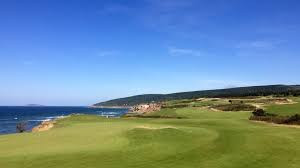The golf course is often called another name, Golf-link, which refers to the area of the course where golf matches are held as determined by the organizing committee.
Each golf course (or Golf course) will include different types of holes. At the position of each hole, there will be a teeing ground, a fairway area, rough grass, and other obstacles that are flexibly arranged according to each golf course design to help players have a new feeling when playing and at the same time. It is also a challenge for golfers.
Golf courses often have very diverse terrain, which is a combination of plots, sand dunes, and many other obstacles. Normally, a Golf course will have 18 standard holes, in small courses with only 9 holes, players can play 2 rounds similar to playing 1 round on an 18-hole course.
Links Course
First and foremost, the Links Course is the most popular golf course. The term comes from the Old English line. This means rugged terrain of ridges and refers to sandy areas along the coast. Many courses claim to be linked and call themselves the link style or include the word link in their names, but the categories are more specific.
True Links courses are found primarily in Scotland, Ireland, and the United Kingdom. The course is along the coast with a sandy bottom below. The land was useless for agriculture, so people looked for other uses. Sandy soil is very well-drained and keeps the soil in place.
Ideal for various golf courses. Some of these courses are Old Course in St Andrews, Royal Troon, La Hinchi, and Bandon Dunes Golf Resort.

Parkland Course
The Parkland Course is built inland away from the sea. These places are often full of trees and lush grass. You've probably seen many Parkland courses if you take the PGA Tour. It is called the Parkland Course because it looks like you are playing golf in the park.
This ensures that the green course is usually well maintained and filled with man-made features such as excavated bunkers, ponds, and stacked roughs. Parkland courses are often built in places where golf is not ideal. This means that grass and soil are difficult and expensive to maintain.
There are few movements and uplifts in the natural land, so course architects on the Parkland course need to do more to add charm and excitement to the course.
Heathland
The easiest way to understand Heathland is to read the definition of heath. Most health courses are in the UK. These inland golf courses tend to be more open than the Parkland courses because their style is based on the links course. The pitch is often populated with gorse and heather and is usually not as well maintained as the traditional green pitch.
Most of them have few trees (mainly pine), but many have grown trees for many years. These courses were born when people looked for a golf course other than Links Land. The terrain is often hills, like links, and the sandy bottom.
Many of the best courses in the UK are heathers such as Woking Golf Club, Sunningdale Golf Club, and Alwoodley Golf Club.
Sandbelt Courses
Australia's Sandbelt region has some of the most popular golf courses globally, but in some places, you can get lost in the mix. The Sandbelt region is just outside Melbourne, Australia, and is home to some of the best golf courses in the world. The ground in this area is surprisingly sandy compared to the surrounding area and is ideal for golf.
This soil is ideal for rugged greens and terrain with solid treads. The ground is also ideal for steep bunkers around the green. Famous golf course type architect Alister MacKenzie visited the sands in 1926, designing the west course of Royal Melbourne and advising several other courses.
Stadium / Championship Course
These two terms often come together. These are courses designed for large and small golf tournaments. In most cases, clubs that say they have a championship course have no meaning other than 18 holes, are quite long and tough.
The term "championship" is often used to distinguish between courses when the club has multiple courses to choose from. However, you can also define a "championship course" as a course that hosts a major tournament. This will significantly reduce the list. The definition of a stadium course can be a bit narrower. The TPC course occupies most of the "stadium course" because it was built with the audience of the PGA Tour event in mind.

Desert course
Desert courses are often green oases surrounded by arid sandy landscapes in the area. These courses work in natural dunes and other terrains, but their lush grass is unnatural for the region. It requires a lot of watering. The desert course is only available in parts of the world with a desert climate.

